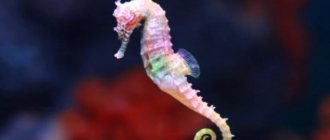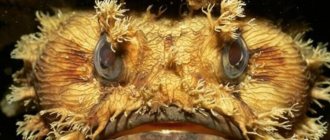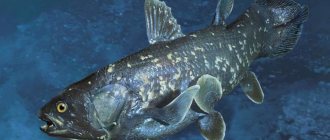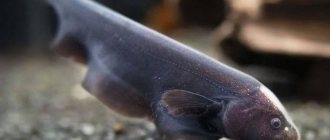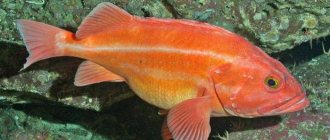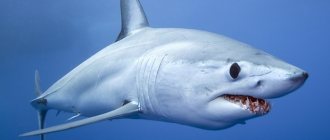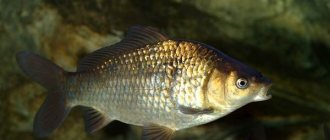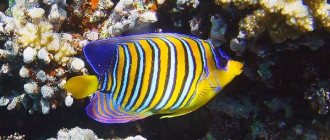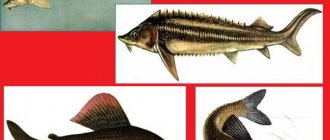- Wild animals
- >>
- Fish
The anglerfish is an unusual deep-sea creature, reminiscent of monsters from a fairy tale. Amazing and unlike others. All external features are adapted to live under a huge thickness of water, in dark and impenetrable depths. Let's try to study their mysterious fish life in more detail, focusing not only on appearance, but also on characteristic habits, disposition, methods of reproduction and food preferences.
Sea devils - description
| Class: | Ray-finned fish |
| Squad: | Anglerfishes |
| Family: | Anglerfish |
| Genus: | Anglerfish |
| View: | European anglerfish |
| Scientific name: | Lophius piscatorius |
Due to its deep-sea habitat, this species is poorly studied. It is also called the sea scorpion or fishing frog due to its special fishing rod on its head.
Photo: monkfish with prey in its mouth
Scientists suggest that the first monkfish appeared more than 100 million years ago. Their specific appearance is due to a long period of adaptation to deep-sea habitat conditions.
Some people believe that monkfish and anglerfish are two completely different fish. In fact, when they talk about monkfish, they mean a specific species - the European anglerfish. It is not so scary in appearance and is what is most often eaten. It is found at a depth of 200-250 m. But deeper-sea species are caught much less frequently. But both of them belong to the same group.
Approximately how much does it cost?
Anglerfish, called yellow angler (Lophius piscatorius), monkfish with footfish - this exotic fish is bred in public aquariums. The price of one fish is 110-180 dollars.
The depths of the deep-sea kingdom are fraught with many unsolved mysteries and secrets. The monkfish has not yet been fully studied, and other original inhabitants also arouse interest and curiosity.
I would like the reader, after reading the material, to share his impressions and leave a comment.
What does monkfish look like?
Females have the characteristic appearance of monkfish. Depending on the species, the appearance of the fish may differ, but the main characteristics are the same:
Photo: caught anglerfish
- bare skin that has growths but no scales;
- flattened body with a wide head;
- “fishing rod” - the front part of the dorsal fin with a flashlight at the end.
The species received its name from the Spanish conquistadors more than 500 years ago, when they first caught this fish. They were so amazed by her appearance that they were sure that they had caught the sea devil himself.
Photo: monkfish in water
The skin of an anglerfish has growths that are very similar in appearance to the bottom and algae. The skin can hang down like a fringe, merging with the bottom soil. The color of the monkfish is motley, similar to bottom sand.
- Fish grow up to 2 m in length and weigh up to 60 kg.
- The predator's mouth is lined with sharp teeth, sometimes in 2 rows, and the lower jaw is usually pushed forward.
- The eyes are small, see very poorly, and are located quite far from each other. At its usual habitat depth, vision is of little use to this fish. Constant darkness allows this fish to hide well, but also hides potential prey and males from it.
- It has another interesting adaptation - illium. That’s what her “fishing rod” is called. At the end of the illium there is an escu - a sac with luminescent bacteria. The fish can control its “lantern” and turn it on only when necessary. Light in such pitch darkness makes it easy to attract prey. And the huge mouth and razor-sharp teeth are capable of swallowing an opponent who is even larger than the devil himself.
Sexual dimorphism
Angler fish have pronounced sexual dimorphism. The female is significantly larger in size than the male. She has a large mouth and powerful curved teeth. The stomach intensively stretches, which allows it to eat quite large caught fish in one hunt. Her fishing rod is a transformed first feather of a fin. This is illicium, which is equipped with a hook at the end. Such a transformed feather serves as a luminous point, which during the hunt plays the role of bait. The glow is caused by luminescent bacteria that inhabit the mucus-filled gland. Fish stimulates more or less intensive blood supply to this part of its body by narrowing the walls of the artery. Thus, it either provides oxygen to bacteria or blocks it.
But males do not have such a fishing rod. Therefore, they look different compared to females, and use slightly different hunting methods.
Illicium varies among females. It has a different design for different breeds of this animal. In the European devil, it extends from a special canal, hanging over the lower jaw, which can be seen in the photo. As the prey approaches the animal's mouth, the rod retracts, bringing the fish closer to its demise. This is how devil fish hunt in conditions of complete darkness, in a deep-sea habitat.
The sexual dimorphism of the female anglerfish in comparison with the males looks even more interesting if we analyze the body size of this animal. In females, depending on the species, the actual length is from 5 cm to 100 cm. Whereas in males, the minimum length is 16 mm and reaches a maximum of 4 cm. We can talk about the difference in size by comparing the parameters tenfold.
There is real parasitism in relations between the sexes. Small males live on the body of the female. Their dwarf size allows them to do this. But this happens gradually - at first the male develops as a full-fledged fish. Then, when he reaches puberty, he finds a female. He can do this by the smell of pheromones, body color, shape of the fishing rod or other characteristics. It then attaches its teeth to the female's side. Gradually he grows into her with his mouth, the fusion occurs so intensely that he begins to feed on the same bloodstream as her. It becomes a simple appendage that lives only to produce sperm and fertilize its “mistress.”
Species of monkfish
The anglerfish family is quite diverse. But the most popular and widespread are 5 types of monkfish:
American monkfish
Reaches a length of 90 cm, weighs up to 22 kg. Among angler fishermen it is rightfully considered a long-liver. Life expectancy is up to 30 years. It is currently endangered due to overfishing. It lives in the waters of the northwestern Atlantic at depths of up to 670 m.
Black-bellied anglerfish
Smaller than the American one, it grows 50 cm in length, although sometimes specimens up to 1 m are found. Life expectancy is 20 years. Found in the eastern Atlantic, Mediterranean and Black Seas. The usual depth is from 300 to 650 m.
Western Atlantic anglerfish
Reaches 60 cm, lives in the western waters of the Atlantic Ocean, as its name suggests. The main share of the catch belongs to Brazil.
Far Eastern monkfish
Reaches a length of 150 cm. Lives in the Sea of Japan. This species is the deepest of those listed - it is found at depths of up to 2000 m. It is also a popular commercial fish.
European anglerfish (Lophius piscatorius)
A real record holder among his brothers. Body length up to 2 m, weight up to 57 kg. It lives in the Atlantic Ocean at a depth of up to 550 m. It is mined in England and France.
Video: Anglerfish
In general, all anglerfish are distinguished by extraordinary and strange external features, necessary for fish to live at great depths. The main difference between anglerfish is their modified dorsal fin, which hangs close to the fish’s mouth and resembles a fishing rod with a bait (eska) at the end. This unusual fishing rod is called illicium, and because of its presence of fish, it is nicknamed anglerfish.
Interesting fact: Among angler fish, only females have a fishing rod.
All anglers are divided into 11 families, which consist of more than 120 species of fish. Different types differ not only in places of permanent deployment, but also in size, weight, and some external features.
Among the varieties are:
- black-bellied (South European) anglerfish;
- Far Eastern anglerfish;
- American anglerfish;
- European anglerfish;
- Western Atlantic anglerfish;
- cape anglerfish;
- South African anglerfish.
Fishing rods for females have a different structure, shape and size, it all depends on the type of fish. Various skin growths are possible on illicia. Some anglers have the ability to fold and expand using a special channel on the spine. The esca, shimmering in the darkness, is a gland that is filled with mucus containing bioluminescent bacteria. The fish itself causes the glow or stops it, expanding and narrowing the blood vessels. The light and flashes from the bait are different and individual for each type of fish.
Where does the anglerfish live?
The habitat of the monkfish is quite large. Representatives of this species can be found in the depths of the eastern Atlantic Ocean, the Black and Mediterranean seas. It is mined in the waters of the Sea of Japan, the North and Baltic Seas, as well as in the Okhotsk and Yellow Seas.
The sea anglerfish stays closer to the bottom, at a depth of 200-250 m and below. Larger individuals can go to depths of up to 2 km. During periods of prolonged hunger or immediately after spawning, many individuals rise higher, go into shallow water and even hunt birds.
general information
Monkfish belongs to the ray-finned fish of the anglerfish family . An adult fish grows up to 2 meters in length and weighs at least 20 kg. But most often you come across individuals up to 1 meter in size and weighing up to 10-12 kg. The sea devil has a flattened, disproportionate body and a very large head, which can occupy 2/3 of the body. Colored brown with a greenish or red tint. The abdominal cavity is white.
The mouth is large and wide with sharp and concave teeth. The skin has no scales. The eyes are quite small, seeing almost nothing, and the sense of smell is also very poorly developed. Around the anglerfish's mouth there are folds that periodically move, creating the appearance of algae.
The anglerfish has a disproportionately large head and reaches quite impressive sizes.
The front fin plays a special role in the life of a fish. It has six rays, half of which grow separately. One of them hangs forward and forms a fishing rod, thanks to which the fish received another name - the European anglerfish. The rod is equipped with a base, fishing line (the thin part) and a luminous bait.
https://youtube.com/watch?v=FWSq6DDGcrE
What does an anglerfish eat?
All anglerfish are predators. They eat all living creatures that come their way: fish, deep-sea squid, shrimp, even waterfowl. Their stomach is dimensionless, and their hunger is almost insatiable.
Sea devils are very voracious. Their stomach allows them to swallow prey that can exceed the size of the fish itself. Fishermen say that if a monkfish gets into the net along with another catch, then it is able to eat all the rest of the fish.
But the structure of the jaw is such that the monkfish cannot spit out its prey. The sharp teeth are curved towards the mouth, and in some species such teeth grow not only above and below, but also in two rows. When the mouth opens, low pressure is created, creating a vacuum that literally sucks the victim in. Therefore, without calculating the strength and without comparing the sizes, the monkfish often dies by choking on an overly large meal or bird feathers.
Natural enemies of the anglerfish
Photo: Male anglerfish
The angler fish has practically no enemies in natural conditions. Apparently, this is due to its very deep-sea lifestyle, terrifying external features and unsurpassed talent for camouflage. It is almost impossible to see such a fish at the bottom, because it merges with the surface soil to such an extent that it forms one whole with it.
As already mentioned, one’s own greed for food and excessive gluttony often ruin fish’s lives. The anglerfish swallows prey that is too large, which causes it to choke on it and die, because it is not able to spit it out due to the special structure of its teeth. It is not uncommon to find prey in the stomachs of caught monkfish, which is only a few centimeters smaller in size than the predator fish itself.
The enemies of anglers include people who fish for this extraordinary fish. Monkfish meat is considered a delicacy; it has practically no bones and has a dense consistency. Most of this fish is caught in the UK and France.
Interesting fact: There is evidence that every year from 24 to 34 thousand tons of the European variety of anglerfish are caught all over the world.
Angler fish meat has a sweetish and delicate taste, it is not at all fatty. But they mainly use the tail part of the fish for food, and everything else, as a rule, is considered waste.
Natural enemies
Monkfish have almost no natural enemies. Their appearance allows them to carefully camouflage themselves at any bottom, and their gluttony and cunning hunting allow them to defeat opponents that are larger than them. In addition, at the depths in which the angler fish prefers to live, there are quite few inhabitants. The anglerfish rarely encounters large sea predators, but it can defeat all small ones without much damage, since it is at the top of the food chain.
The anglerfish is not of particular nutritional value for marine life, since the bulk of its body mass is in its head and huge mouth. Not a single inhabitant of the depths purposefully hunts him.
Anglerfish with an open mouth
The enemies of the anglerfish are considered to be giant squids, large octopuses and dragon fish, isopods, goblin sharks and “hell vampire” mollusks. Quite large anglerfish were found in the stomachs of these marine inhabitants.
The main damage to the population comes from the consumption of tadpoles and eggs by whales, sharks and other marine fish. Anglerfish do not protect their young, and therefore they drift into the waters, left to the whims of fate.
The main enemy of monkfish can be considered the person who catches it on an industrial scale. More than 30 thousand tons of this marine life are caught annually. In countries such as Brazil or France, the catch is put on stream, and the products are also exported to other countries.
Curious facts
The surrendered fish is associated with the following interesting facts:
- When buying a female anglerfish on the market, quite often you can buy not 1, but 2 fish at once. The male in adult females is attached to one of the sides. Sometimes it manages to form a shoot, losing its original appearance.
- Today, commercial fishing of this fish is prohibited in the USA and Britain. Therefore, it is impossible to find it in large supermarkets. You can try real monkfish either in one of the Mediterranean countries or in Asia.
- There are several varieties, and they all look different. How different the body shape and appearance of different monkfish differ can be seen in the photograph.
- The anglerfish is believed to have existed in prehistoric times, becoming one of the first species of marine fish.
Features of character and lifestyle
Sea devils are significantly different from other representatives of the animal world. This is manifested not only in appearance and method of hunting. Thus, sexual parasitism is common among anglerfish, and males are so different from females that some time ago they were classified as different species. There was even a theory that anglerfish are hermaphrodites. But in reality everything is much more complicated.
Reproduction and offspring
The reproduction process of monkfish can amaze no less than their appearance. Males search for a female by smell. Their sizes are simply incomparable in relation to each other, and therefore they reproduce in a very non-standard way.
- The male chooses a female for himself, then attaches himself to her and gradually loses himself, becoming literally one with her - he begins to feed at her expense, gradually loses his organs, becoming just a shoot with a single fertilizing function.
- For a successful suction process, it is important for the male to choose the right position to approach the female. Potential brides have very poor vision, and therefore may inadvertently eat the future groom.
Different species of anglerfish are ready to spawn at different ages. For some, this occurs almost immediately after transformation from a tadpole, while for others, for example, the European anglerfish, the appropriate age occurs only at the age of 14.
Female anglerfish and male
For spawning, which occurs in the spring, anglerfish often go to greater depths than usual. During one spawning, the female is capable of producing up to 3 million eggs. The caviar is spawned in the form of a long and wide ribbon. The size of the eggs can reach 4 mm. Females do not keep track of the eggs. They mark her and swim away. After a few days, the eggs turn into tadpoles, which feed on plankton. After 4 months, defenseless fry are able to settle to depth on their own.
Certain species of deep-sea anglerfish spawn in certain secluded places. Males fertilize the eggs at the spawning site. In the same way, fish do not monitor their offspring and do not protect them.
Male parasitism
Anglerfish are known for their sexual parasitism. And this process has hardly been studied by modern scientists. They know for sure that the male parasitizes the female, becoming her appendage. And there can be up to six such parasites on one fish at a time. Moreover, if the male has not found a female, he dies very quickly.
Female anglerfish and several males
Males have more developed vision and hearing, but nevertheless they are not able to survive without a female. Males bite into the female’s body, feed on her nutrients, gradually acquiring blood vessels.
There is a theory that the monkfish fish has some kind of alternative version of immunity, which gives it the opportunity not to reject the attached parasite, but to accept it and allow it to germinate.
Features not related to reproduction
A deep fish with a fishing rod on its head has many other differences from the usual inhabitants of the water.
- For example, she does not have a swim bladder. It allows other representatives of aquatic flora not to drown under their own weight. But the angler fish lives at sufficient depths that it simply does not need such an organ.
- Another feature that is of great interest to scientists is where the luminescent bacteria that live in its “fishing rod” come from in fish. There are two theories. According to the first, the eggs are received by bacteria from the mother. The second theory is that females simply encounter these bacteria while they swim.
- The glow occurs with different intensities. There may be flashes, increased or decreased glow. Scientists have not yet been able to study this point either. It is believed that this may be related to blood supply and the amount of oxygen.
Appearance and features
Photo: What an anglerfish looks like
As already noted, the female differs from the male in the presence of a special fishing rod used to attract prey. But the differences between the sexes don’t end there; male and female anglerfish are so different that scientists used to classify them as different species. Male and female fish vary greatly in size.
The females are simply giants compared to their males. The dimensions of females can vary from 5 cm to two meters, the weight can reach up to 57 kg, and the length of males does not exceed 5 cm. These are the colossal differences in parameters! Another sexual dimorphism lies in the fact that miniature cavaliers have excellent vision and sense of smell, which they need to detect a partner.
The sizes of anglerfish vary among different species; we will describe some of them. The length of the body of the European anglerfish can reach up to two meters in length, but, on average, it does not exceed one and a half meters. The largest mass of such a large fish ranges from 55 to 57.7 kg. The body of the fish is devoid of scales; it is replaced by many leathery growths and tubercles. The body of the fish is flattened, compressed from the ridge and abdomen. The eyes are small and located quite far from each other. The fish's spine has a brown or greenish-brown tint, there is also a reddish tone, and there may be dark spots on the body.
The length of the American anglerfish ranges from 90 to 120 cm, and its weight is about 23 kg. The dimensions of the black-bellied anglerfish vary from half a meter to a meter. The length of the Western Atlantic anglerfish does not exceed 60 cm. The Cape monkfish has a huge head, which is noticeably flattened, and the fish’s tail is short. The length of this fish usually does not exceed the meter mark.
The Far Eastern anglerfish grows up to one and a half meters, its head section is very wide and flattened. Immediately noticeable is the large mouth and the lower jaw, which is pushed forward, which is equipped with one or two rows of sharp teeth. The fins located on the chest are quite wide and have a fleshy blade. On top, the fish is colored brown with spots of a lighter shade, which are framed by a dark border. The belly has a lighter shade.
Interesting fact: Sea devils move along the bottom surface using jumps, which they can make thanks to their strong pectoral fins.
In general, angler fish are simply masters of camouflage; they completely merge with the bottom, becoming practically indistinguishable from the ground. All sorts of bumps and growths on their body contribute to this. On both sides of the head, angler fish have overhanging skin in the form of a fringe, which also runs along the jaw, above the fish lips. Externally, this fringe is similar to algae swaying in the water column, because of this the fish camouflages itself even more closely with its surroundings.
Interesting fact: An anglerfish caught from the depths looks completely different from what it does at the bottom. He becomes swollen, and his eyes seem to be coming out of their sockets, the whole point is due to excess pressure, which at a depth reaches 300 atmospheres.
How long do anglerfish live?
The length of the life cycle varies depending on the species. Thus, the European monkfish can live on average 17-20 years. The American angler lives much longer - about 30 years, and the Cape one - no more than 10 years.
Anglerfish head
The lifespan of a monkfish depends on many factors: the amount of food, what it actually gets to eat, and what it catches by humans.
Population and species status
Photo: What an anglerfish looks like
As previously reported, the anglerfish is a commercial fish. To catch it, special bottom trawls and gill nets are used, so deep-sea habitat does not save this unusual fish. The catching of European monkfish by the thousands of tons is leading to a decline in its population, which is worrying. The fish suffers because of its dense and tasty meat, which has almost no bones. The French especially know a lot about monkfish dishes.
The Western Atlantic anglerfish is caught in Brazil; 9 thousand tons are caught annually around the world. Angler fishing on a large scale has resulted in the fish becoming rare in certain habitats and considered endangered. This, for example, happened with the American monkfish, of which there are very few left due to overfishing, which causes concern among many environmental organizations.
So, the population of anglerfish is declining. The love for delicious fish meat led some species to the threat of extinction, because this fish was caught in huge quantities. In some countries and regions, the anglerfish is considered to be listed in the Red Book and requires special protective measures so as not to completely disappear from the deep sea.
Does the anglerfish pose a danger to people?
This predatory fish does not pose a real threat to humans.
Firstly, a person rarely gets to the depths familiar to an angler, being at least without protection (a bathyscaphe or a spacesuit).
Angler fish skeleton model
Secondly, even a very voracious devil will not be able to eat an entire adult without choking.
However, the sharp teeth of this fish can cause serious injury to the limb. After spawning, many anglerfish rise closer to the surface of the water to feed. There are known cases when scuba divers encountered the devil in shallow water. And in 2013, a video appeared in which an angler grabbed an underwater hunter by the hand (but this happened more likely after the fish was taken out of the water).
Living conditions and character of the anglerfish in its native environment
Sea devils live in underwater depths from 50 to 200 m, closer to the very bottom, its native element, where it can lie in complete peace on a sandy or muddy bed, or among stones.
But don’t think that he is lying inactive. This is his way of hunting for prey. The angler lies motionless and waits. And the moment the prey swims nearby, it instantly pounces on it and absorbs it.
And it happens that with the help of fins, it jumps and begins to chase the victim and successfully overtakes it. Anglers are predatory fish.
Features of keeping in an aquarium
A specific type of anglerfish from the clown anglerfish family is most often kept in aquariums. Their size does not exceed 20 cm. The main requirement for their maintenance is the absence of neighbors. Even small sea devils remain voracious predators and masters of camouflage. Therefore, any fish in the neighborhood will have no chance of survival.
Anglerfish do not control their appetite, and therefore it is very important to choose the feeding rate. They die from overfeeding and wither away from hunger. They only eat live fish. It is almost impossible to get used to frozen food or seafood. Optimal conditions for keeping one fish: 250-300 liters of water with a temperature of 24 to 27 degrees.
Curious facts
Anglers, when hungry, are able to catch larger prey than usual. And because of the structure of their teeth, they cannot release it back, and in the end they may even die.
The presence of a “fishing rod” is characteristic only of female anglers. Each species has its own bait. The glow is emitted by bacteria contained in the mucous membrane of the skin bulb, due to oxygen. The glow is regulated by the individual itself.
If the anglerfish is full, the glow stops because the oxygen supply stops as a result of squeezing the vessels. If he is hungry, the glow resumes and he is ready to hunt!
Interesting Facts
- The anglerfish can move along the bottom surface by jumping. Its pectoral fins are so developed that they allow it to push off and make sharp jumps. Most often, this skill is used during hunting for a sharp and unexpected attack on prey.
- At the bottom the pressure reaches almost 300 atmospheres. Therefore, when a monkfish is raised to the surface, its body changes: the fish swells, and its eyes seem to be popping out of their sockets.
- Male monkfish have an excellent sense of smell. They look for a female, focusing not only on her appearance, but also on her smell. Females secrete special pheromones. And their fishing rods differ depending on the specific species. This landmark also helps males search for suitable individuals.
- In some species of monkfish, the length of the fishing rod can exceed the size of the fish itself by 4 times. Such anglerfish are called gigantaxis.
- A species of devil called the Greenland ceratia can not only turn off its “lantern”, but also fold it. There is a special hole in their back into which the fishing rod is simply retracted when not needed.
Angler on board a fishing boat
Nutrition and reproduction
They prefer to hunt other deep-sea fish. Often their prey is representatives of the orders Gonomostomera, Melamphaidae or Howlidae.
Sometimes the anglerfish hunts crustaceans, feeds on mollusks or cuttlefish or small squid.
The difference between fish, in terms of hunting reflexes, is a high level of gluttony. They often attack prey that is several times larger than their own body size. True, such a result of the hunt most often ends disastrously for the devil fish itself. She simply dies from choking on her prey. She can no longer spit out because of her teeth that are bent back.
Reproduction
A small population with a large range and a low probability of meeting a partner provoked the development of an original mating strategy. Researchers were unable to detect male anglerfish for quite some time; the females caught seemed to be infected with parasites. It turned out that the matter here is not only in pronounced sexual dimorphism, but also in the method of reproduction - parabiosis, i.e. The species practice sexual parasitism.
The male visually or by pheromone trail finds the female, bites into her body with his teeth, after which the fish grow together almost into a single organism, the male is not just a symbiont, he is a parasite, feeding from the common circulatory system, over time loses the ability to move independently and survive, dissolves some organs (eyes, fins) by injecting a special enzyme.
No developed gonads (testes) are found in the caught male specimens. Their digestive tract development slows down, and the jaws of some species are not suitable for independent feeding. Such males are not able to mature without attaching to the female body. In others, the organs of orientation are highly specialized and developed only for searching for a mate.
Such a symbiotic relationship continues throughout the life of the female, the reproductive functions of the active and dependent side are preserved throughout this time, so that the male can take part in several spawnings, and guarantee the conservation of the species, since each individual is paired with an opposite sex in the early stages of growth.
This method is not inherent to all types of anglers. For some, the symbiosis is facultative or regular temporary contact is used during the mating season.
Spawning takes place at great depths, despite the absence of seasonal fluctuations in water temperature, and occurs in spring or summer. The eggs are thrown in large gelatinous ribbons or “rafts” up to 10 m in length, about 25 cm wide, in a layer of about 0.3-0.6 cm. Light eggs interspersed with fat in the millions gradually float to a depth of 200 m, where the fry develop and transform into adults. And only after that they go back deep into their familiar habitat.
Far from being a beauty
Even adults can be frightened by angler fish, or their appearance can be used as a basis to create a particularly creepy monster movie. This sea creature has an appearance that is the complete opposite of ideas about harmony and beauty : the spherical body is disproportionate, with the head taking up most of it. The lower jaw protrudes forward, the mouth is huge, and when the fish opens it, sharp needle-like teeth curved inward are visible. But not only this can cause panic. Around the mouth there are leathery folds that constantly move, and instead of scales, the naked body is covered with spines. The skin itself is rough and warty. The fish has small eyes, but when it is lifted from the depths, it experiences excess pressure, so the eyes become bulging and the body is swollen.
Huntress of the distant depths
- Deep-sea anglerfish comprise 11 families and more than a hundred species . They have a so-called fishing rod, or illicium, a natural device that allows the fish not to be left without food. Having examined representatives of these species, scientists found out that this is an overgrown dorsal fin, the first ray. Some fish can hide it by retracting it into their body, and some have it in their mouth.
- This unusual device, gifted to the angler by nature, is very convenient during hunting. In many species, such a unique fishing rod is located in front of the muzzle and hangs directly from the mouth. At the very tip there is a bait - eska .
- Such a process in some species can be four times larger than the fish itself.
- The esca looks like a small leather pouch , but in fact it is a gland containing mucus and bioluminescent bacteria. It is thanks to these microorganisms, of which there are millions, that the tip of the eski glows.
- The fish itself and the periodic flashes of its rod look creepy. She is able to cause a glow and adjust its brightness, having the ability to control the condition of blood vessels: expand them and narrow them. Everything in this process is thought out: the gland needs blood flow, and the bacteria need oxygen.
- The habitat of this unusual fish is almost three kilometers deep in the Pacific Ocean . It is often found in the Atlantic Ocean - it prefers to live in cool temperatures.
- These fish move little , but are excellent hunters, and due to their dark brown or black color, they are very difficult to notice in the impenetrable water depths. In search of food, they sink to the bottom and hide in algae or mud. But only females hunt and have escues. Males only need to eat small organisms, such as copepods.
- To make other fish think that there are small fish here, the angler turns on his fishtail and sets it in motion. Now it may indeed seem that a school of fish is rushing about in one place. And gullible fish swim here, not suspecting that they themselves will soon become food.
- The anglerfish has enviable patience : it will not reveal its presence until the prey gets very close and can even hold its breath, taking inhalations at intervals of 1-2 minutes .
- The fish pulls small prey into itself along with the water, and this happens in seconds. And sometimes the anglerfish jumps out of an ambush; it does this quickly and easily thanks to its powerful pectoral fins or by releasing streams of water through its gills.
- These individuals are very voracious , and their stomach can stretch to enormous sizes. But it happens that a successful hunt can end in the death of an anglerfish, since its victim can become a sea creature several times its size. In addition, the teeth curved inwards do not allow one to get rid of large prey, and the anglerfish can choke. The fact that the fish’s mouth is larger than the esophagus also poses a health hazard.
- But the angler fish itself is valued as a delicious delicacy dish . It is included in the list of commercial fish due to its dense white meat with no bones. The tail part is used for cooking, and the head is boiled, and a delicious soup is obtained.
Comparison with a shark
In terms of their hunting method, fancy anglerfish are similar to smooth-skinned sharks, but their life is spent in deeper waters than those of the oceans.
Sharks live in the upper and middle layers and receive much more heat, light and food. Monkfish tend to go deeper, which is why it is exposed to higher pressure, the water temperature here is noticeably lower, the sun's rays are scattered and absorbed so much that living organisms vegetate in eternal darkness. To successfully hunt, they have developed camouflage mechanisms that allow them to blend in with their surroundings and become like algae, stones or corals. The shark doesn’t need this; it is active and formidable.
Oceans at great depth are sparsely populated. But despite its meager diet, the anglerfish remains a predator. Like bottom sharks, this fish is sedentary and has developed passive methods of obtaining food. The difference is in the hunting method - the monkfish can patiently hide at the bottom or drift without actively pursuing prey.
Their food preferences are also different. Sharks are omnivores and can graze or even eat mammals; anglerfish feed on fish and shellfish.
Yandex picture
